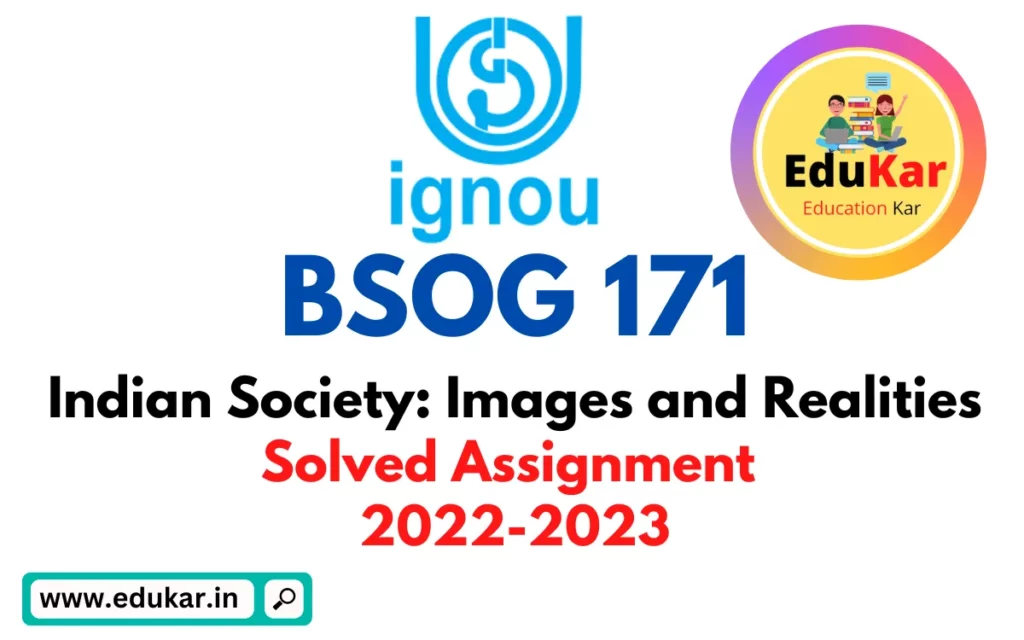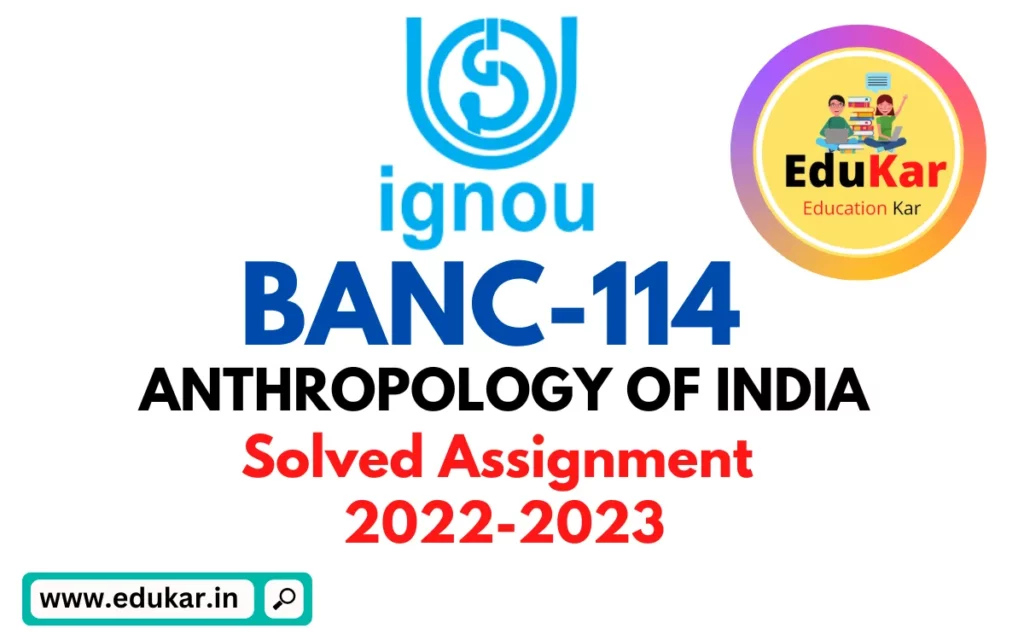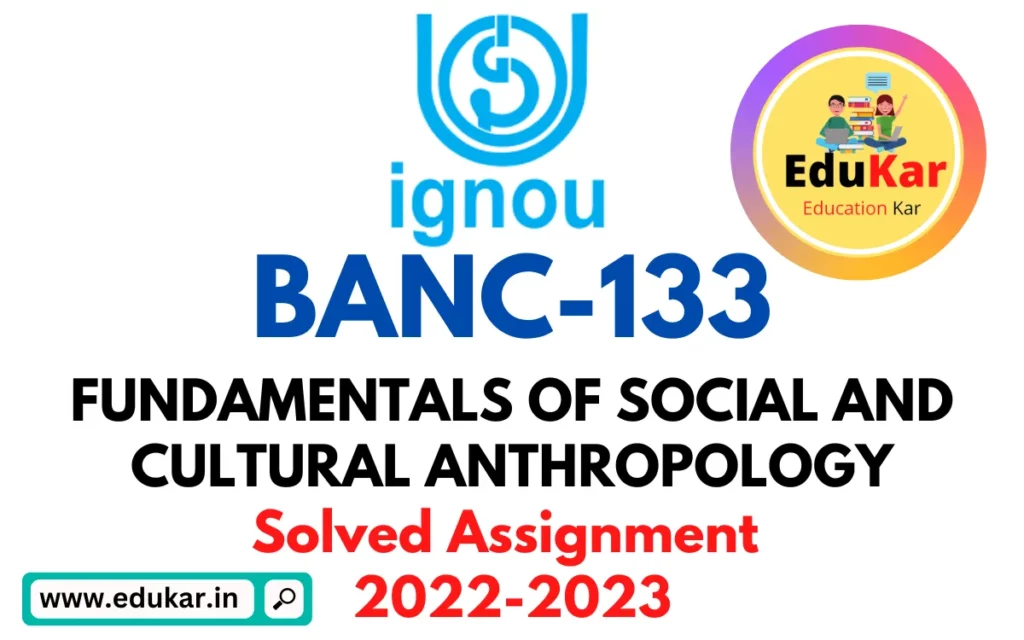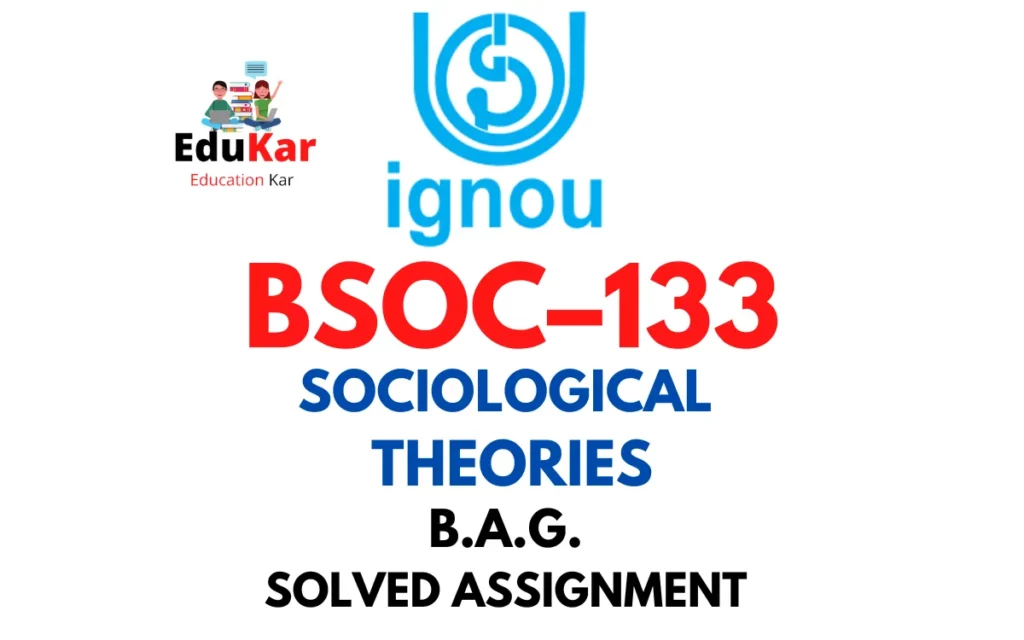Contents
- 1 Assignment A
- 2 Answer the following in about 500 words each.
- 3 1. Who are the Indologists? Discuss their contribution to the understanding of Indian society.
- 4 2. Describe the different types of industries in India with examples.
- 5 Assignment B
- 6 Answer the following questions in about 250 words each.
- 7 3. Compare the Missionary perspective with that of the Orientalist and the Indologists.
- 8 4. Who are the subalterns and when did the subaltern studies emerge in India?
- 9 5. How does the informal economy differ from the formal economy? Explain.
- 10 Assignment C
- 11 Write a note on the following in about 100 words each.
- 12 6. What is jajmani system?
- 13 7. Define the concept of tribe.
- 14 8. Discuss briefly the impact of globalisation on tribes in India.
- 15 9. How does Emile Durkheim describe the relation between religion and society?
- 16 10. List the four types of economy based on the way scarce resources are distributed in society.
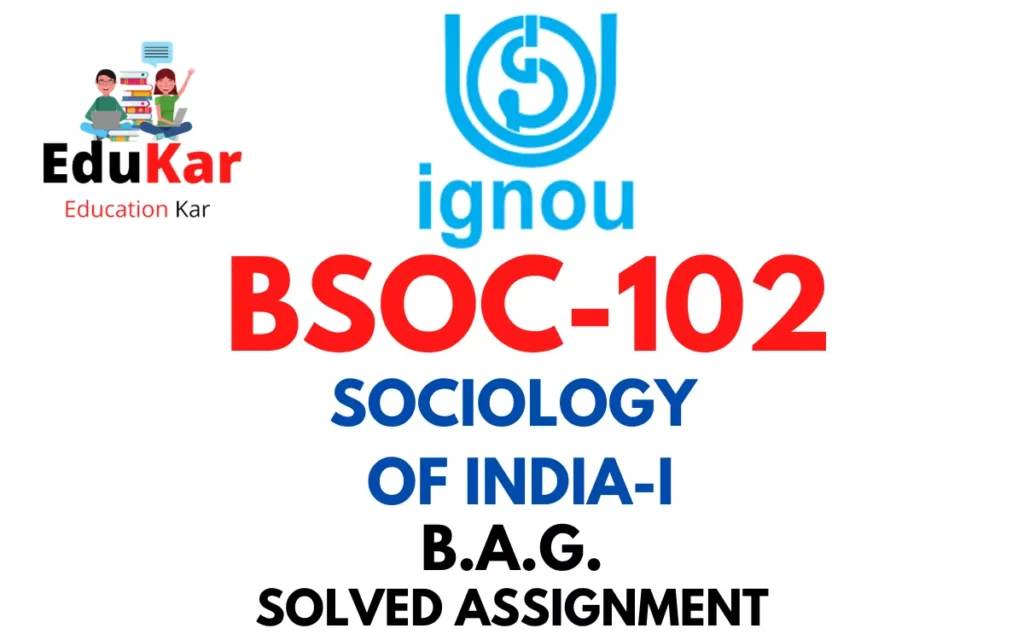
| Title | BSOC-102: IGNOU BAG Solved Assignment 2022-2023 |
| University | IGNOU |
| Degree | Bachelor Degree Programme |
| Course Code | BSOC-102 |
| Course Name | SOCIOLOGY OF INDIA- I |
| Programme Name | Bachelor of Arts (General) |
| Programme Code | BAG |
| Total Marks | 100 |
| Year | 2022-2023 |
| Language | English |
| Assignment Code | ASST/TMA / 2022-2023 |
| Assignment PDF | Click Here |
| Last Date for Submission of Assignment: | For June Examination: 31st April For December Examination: 30th September |
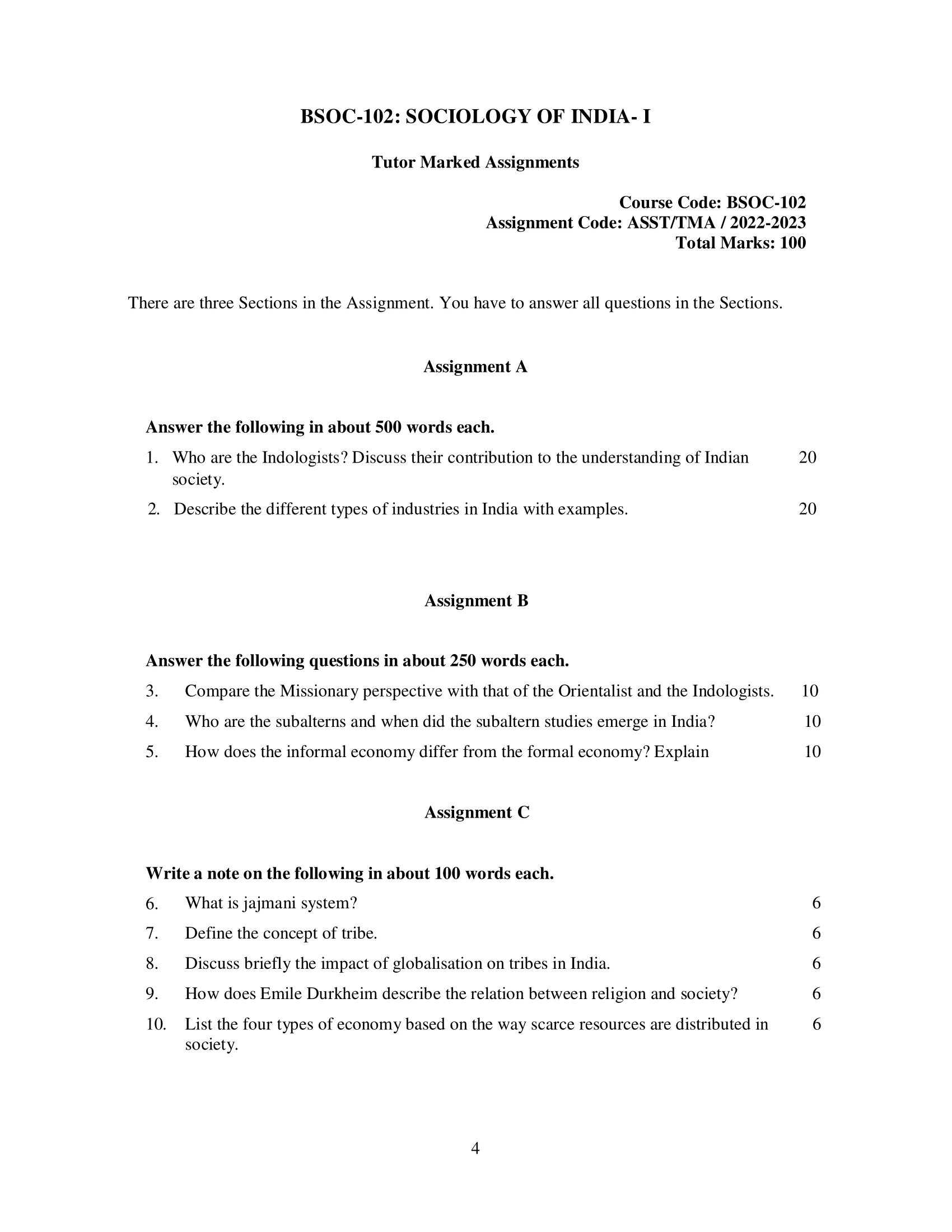
Assignment A
Answer the following in about 500 words each.
1. Who are the Indologists? Discuss their contribution to the understanding of Indian society.
Ans: Indologists are scholars who study the history, culture, language, and religion of India from a non-Indian perspective. They are typically Western scholars who have been interested in India for a variety of reasons, including the country’s rich history and cultural diversity, its philosophical and religious traditions, and its influence on the wider world. Indology as a field of study emerged in the 19th century, when India was still under British colonial rule, and has continued to develop and evolve over the past two centuries.
One of the most significant contributions of Indologists to the understanding of Indian society has been the translation and interpretation of classical texts such as the Vedas, Upanishads, and Bhagavad Gita. These texts are central to Hinduism, which is the predominant religion of India, and contain some of the most profound and complex philosophical and religious ideas in human history. By translating and analyzing these texts, Indologists have helped to make them accessible to a wider audience and have shed light on their meaning and significance.
Indologists have also made important contributions to the study of Indian history, particularly in the areas of archaeology and epigraphy. Through their work, they have helped to uncover and decipher inscriptions on ancient Indian monuments, which has provided valuable insights into the political, social, and cultural life of ancient India. They have also conducted extensive research on the impact of India on the wider world, including the spread of Indian religions such as Buddhism and Hinduism to other parts of Asia and beyond.
In addition to their contributions to the study of Indian society and culture, Indologists have also played a key role in shaping Western perceptions of India. By bringing the richness and complexity of Indian civilization to the attention of Western audiences, they have helped to challenge and disrupt stereotypes and misconceptions about India that have persisted for centuries. Indologists have also fostered cross-cultural dialogue and exchange between India and the West, which has helped to promote greater understanding and appreciation of each other’s cultures.
However, it is important to note that Indology has not been without its controversies and criticisms. Some have argued that Indologists have been overly focused on the study of classical texts and have neglected the study of contemporary Indian society and culture. Others have accused Indologists of perpetuating colonial-era attitudes and biases, and of appropriating and misrepresenting Indian culture and traditions. These criticisms have led to calls for a more diverse and inclusive approach to the study of India, one that incorporates the perspectives and voices of Indian scholars and intellectuals.
2. Describe the different types of industries in India with examples.
Ans: India has a diverse range of industries, from traditional sectors such as agriculture and textiles to emerging sectors such as information technology and biotechnology. Here are some of the different types of industries in India, along with examples:
- Agriculture: India is primarily an agrarian economy, with agriculture being the largest employer in the country. Major crops grown in India include rice, wheat, pulses, and cotton. The country is also a major producer of fruits and vegetables. Some of the major agricultural companies in India include ITC Limited, Godrej Agrovet, and Mahindra Agri Solutions.
- Textiles: India has a long history of textile production and is one of the largest producers and exporters of textiles in the world. The textile industry includes the production of cotton, silk, wool, and synthetic fibers, as well as the manufacture of finished products such as clothing and home textiles. Some of the major textile companies in India include Raymond, Arvind Limited, and Welspun India.
- Automobiles: India is the world’s fifth-largest automobile market, with a rapidly growing domestic market and a strong export sector. The automobile industry includes the manufacture of cars, commercial vehicles, and two-wheelers. Some of the major automobile companies in India include Maruti Suzuki, Tata Motors, and Bajaj Auto.
- Information Technology: India is a leading provider of IT services, including software development, IT consulting, and business process outsourcing. The industry is dominated by large multinational corporations such as TCS, Infosys, and Wipro, as well as smaller startups and niche players.
- Pharmaceuticals: India is one of the largest producers of generic drugs in the world, with a strong domestic market and a growing export sector. The pharmaceutical industry includes the manufacture of both branded and generic drugs, as well as research and development of new drugs. Some of the major pharmaceutical companies in India include Sun Pharmaceutical Industries, Dr. Reddy’s Laboratories, and Cipla.
- Biotechnology: India has a growing biotechnology sector, with a focus on developing new drugs and medical devices, as well as agricultural biotechnology. The industry includes both established players and startups, and is supported by government initiatives such as the Biotechnology Industry Partnership Program. Some of the major biotechnology companies in India include Biocon, Serum Institute of India, and Bharat Biotech.
- Mining: India has significant reserves of minerals such as coal, iron ore, and bauxite, and is a major producer of metals such as steel and aluminum. The mining industry is dominated by public sector companies such as Coal India and Steel Authority of India, as well as private sector players such as Vedanta and Tata Steel.
- Tourism: India has a rich cultural heritage and diverse natural landscapes, which attract millions of tourists every year. The tourism industry includes hospitality, travel and transportation, and entertainment, and is supported by government initiatives such as the Incredible India campaign. Some of the major players in the tourism industry in India include Taj Hotels, MakeMyTrip, and Cleartrip.
These are just a few examples of the different types of industries in India, which reflect the country’s diversity and complexity. Each industry has its own opportunities and challenges, and together they contribute to the growth and development of the Indian economy.
Assignment B
Answer the following questions in about 250 words each.
3. Compare the Missionary perspective with that of the Orientalist and the Indologists.
Ans: The Missionary perspective, the Orientalist perspective, and the Indologist perspective represent different approaches to studying and understanding the culture, religion, and society of the East. While there may be some overlap between these perspectives, they are fundamentally different in their assumptions, methods, and objectives.
The Missionary perspective is characterized by a strong belief in the superiority of Christianity over other religions and a desire to convert people to Christianity. Missionaries viewed non-Christian religions, particularly those of the East, as backward and superstitious, and sought to replace them with Christianity. This perspective was deeply rooted in colonialism and the desire to spread Western civilization and values to the “uncivilized” East. Missionaries tended to be critical of Eastern religions, viewing them as primitive and in need of enlightenment through Christianity.
The Orientalist perspective, on the other hand, was rooted in the desire to understand and appreciate the culture, history, and literature of the East. Orientalists studied Eastern languages and texts and sought to gain a deep understanding of Eastern cultures and societies. Unlike missionaries, Orientalists did not seek to convert people to Christianity but were more interested in preserving and understanding the cultural heritage of the East. However, Orientalists were also criticized for their tendency to exoticize and romanticize the East and for their limited understanding of the complex social and political realities of the region.
The Indologist perspective is similar to the Orientalist perspective in that it seeks to understand and appreciate the culture and history of the East. However, Indology is focused specifically on the study of Indian culture, religion, and society. Indologists study Indian languages, literature, and philosophy and seek to understand the complexity and diversity of Indian society. Unlike missionaries and Orientalists, Indologists do not necessarily view Indian culture as inferior or in need of enlightenment, but rather seek to gain a deep understanding of the complexities and nuances of Indian society.
4. Who are the subalterns and when did the subaltern studies emerge in India?
Ans: The term “subaltern” refers to groups of people who are marginalized and excluded from mainstream political and cultural discourse. The concept of the subaltern originated in the work of the Italian Marxist thinker Antonio Gramsci, who used the term to refer to the groups of people who were oppressed and excluded from participating in the dominant culture and politics of their society.
In the Indian context, the subaltern refers to marginalized and excluded groups such as peasants, workers, women, lower castes, and ethnic and religious minorities. These groups have historically been excluded from political power, cultural representation, and intellectual discourse, and have therefore remained invisible and voiceless in the dominant narratives of Indian history.
The subaltern studies emerged in India in the 1980s as a response to the limitations of mainstream historiography in capturing the diverse experiences and perspectives of subaltern groups. The subaltern studies collective was a group of Marxist historians and intellectuals who sought to challenge the dominant narrative of Indian history, which was largely based on the perspectives of the ruling elites.
The subaltern studies collective emphasized the importance of studying the experiences and perspectives of marginalized groups and communities, and sought to understand the ways in which these groups had resisted and challenged their marginalization. They argued that the experiences of the subaltern were crucial to understanding the complex social, cultural, and political realities of India, and that these experiences had been systematically excluded from the dominant narrative of Indian history.
The subaltern studies collective also emphasized the need to move beyond traditional disciplinary boundaries and to engage with a wide range of intellectual and cultural traditions, including literature, anthropology, and cultural studies. The subaltern studies project has had a significant impact on Indian intellectual and political discourse, and has helped to raise awareness of the voices and experiences of marginalized groups in India.
5. How does the informal economy differ from the formal economy? Explain.
Ans: The informal economy and formal economy represent two different economic systems. The informal economy is often referred to as the underground or shadow economy and includes all economic activities that are not registered or regulated by the government. It involves transactions that take place outside the formal channels, such as unregistered small businesses, street vendors, and casual labor. The informal economy is prevalent in developing countries, where there is a lack of formal job opportunities, weak institutions, and high levels of poverty.
On the other hand, the formal economy consists of all legal economic activities that are registered, regulated, and monitored by the government. It includes businesses and individuals that operate in the open market, comply with tax laws, and follow legal procedures. The formal economy is characterized by stable and predictable employment, secure working conditions, and benefits such as social security and health insurance.
One of the key differences between the two economies is their level of regulation. The informal economy operates outside the legal framework, while the formal economy adheres to rules and regulations. Consequently, the informal economy is largely unregulated, making it prone to exploitation, low wages, and unsafe working conditions. In contrast, the formal economy provides workers with legal protection and better working conditions.
Another difference between the two economies is their contribution to the national economy. While the informal economy is generally not included in official statistics, it is estimated to account for a significant portion of economic activity in many developing countries. The formal economy, on the other hand, is a vital contributor to national income, tax revenues, and economic growth.
Assignment C
Write a note on the following in about 100 words each.
6. What is jajmani system?
Ans: Jajmani system is a traditional system of patron-client relationship prevalent in rural India. Under this system, members of a particular caste or community called the jajmans or patrons, provide economic and social support to members of a specific occupational caste or community called the kamins or clients. The clients provide various services to the patrons, such as agricultural labor, carpentry, or leatherwork, and in return receive payment, protection, and social recognition. This system is based on the principles of reciprocity and mutual dependence, and has been criticized for perpetuating social inequality and exploitation. The jajmani system is gradually losing its significance in modern India, as economic and social changes have led to the emergence of new forms of relationships and interactions.
7. Define the concept of tribe.
Ans: The concept of tribe refers to a social group that shares a common ancestry, language, culture, and territory, and is characterized by a sense of solidarity and belongingness. Tribes are often organized around kinship ties and are typically smaller in size than other types of societies. They may have their own political, economic, and religious systems, and often have a distinctive way of life that sets them apart from other groups.
Tribes are found in many parts of the world, including Africa, Asia, the Americas, and Australia. They may be nomadic or sedentary, and may practice subsistence agriculture, hunting and gathering, or pastoralism. In many cases, tribes have faced marginalization and discrimination by dominant societies, and have struggled to preserve their cultural identity and way of life in the face of external pressures.
The concept of tribe is often associated with pre-modern or “primitive” societies, and has been criticized for being a simplistic and homogenizing way of categorizing diverse and complex social groups. However, it remains a useful concept for understanding the social and cultural diversity of human societies, and for highlighting the importance of community, identity, and belongingness in human life.
8. Discuss briefly the impact of globalisation on tribes in India.
Ans: Globalization has had a profound impact on the tribes of India, and has brought both opportunities and challenges for these communities. Here are some of the key ways in which globalization has affected tribes in India:
- Economic changes: Globalization has led to increased integration of the Indian economy with the global market, which has had both positive and negative impacts on tribes. On the one hand, some tribes have benefited from the expansion of markets for their traditional products such as handicrafts, textiles, and herbal medicines. On the other hand, tribes have also faced competition from cheaper imported goods, which has undermined their livelihoods and led to a decline in traditional occupations.
- Cultural changes: Globalization has brought new cultural influences to India, including through the media, entertainment, and consumer culture. This has led to changes in the values, beliefs, and practices of some tribes, as well as increased exposure to the dominant society’s norms and ways of life. Some tribes have also adopted new technologies and practices, such as mobile phones and cash crops, which have transformed their social and economic relationships.
- Political changes: Globalization has led to the expansion of the state’s regulatory and administrative powers, which has often had negative consequences for tribes. For example, tribal lands and resources have been taken over for mining, dam-building, and other development projects, leading to displacement, loss of livelihoods, and environmental degradation. In some cases, tribal communities have mobilized to resist these encroachments and assert their rights.
- Social changes: Globalization has led to changes in social relationships and identities, as tribes have come into contact with other communities and cultures. Some tribes have become more integrated into the broader society, while others have sought to preserve their distinct identities and ways of life. This has led to tensions and conflicts between different groups, as well as efforts to promote intercultural dialogue and understanding.
9. How does Emile Durkheim describe the relation between religion and society?
Ans: Emile Durkheim was a French sociologist who is widely regarded as one of the founders of the modern sociological tradition. He had a particular interest in the relationship between religion and society, and argued that religion played a crucial role in the formation and maintenance of social order. Durkheim’s views on the relation between religion and society can be summarized as follows:
- Religion as a social institution: Durkheim viewed religion as a social institution that served important functions in society. It provided a sense of meaning and purpose, and helped to create social solidarity by fostering a shared set of values, beliefs, and practices. Religion was therefore a vital source of social integration and cohesion.
- The sacred and the profane: Durkheim distinguished between two types of religious experience: the sacred and the profane. The sacred referred to things that were set apart from the ordinary world and endowed with a sense of awe and reverence, such as gods, spirits, and holy places. The profane, by contrast, referred to everyday, mundane things that were not regarded as sacred. Religion helped to create a sense of the sacred by providing a framework for understanding and interpreting the world in a way that made it meaningful and significant.
- Collective consciousness: Durkheim argued that religion played a key role in creating and maintaining a collective consciousness among members of a society. Through rituals, symbols, and other religious practices, people were able to affirm their shared identity and common values. This helped to reduce social tensions and conflicts, and created a sense of social order and stability.
- Anomie: Durkheim was also interested in the negative consequences of the decline of religious belief and practice. He argued that the loss of a shared religious framework could lead to a sense of anomie, or a breakdown of social norms and values. This could in turn lead to social instability, conflict, and even suicide.
10. List the four types of economy based on the way scarce resources are distributed in society.
Ans: The four types of economy based on the way scarce resources are distributed in society are:
- Traditional Economy: In a traditional economy, resources are allocated based on customs and traditions that have been passed down through generations. Production is often subsistence-based, with little surplus or specialization. Bartering and trade may occur, but money is not commonly used as a medium of exchange.
- Command Economy: In a command economy, the government or a central authority controls the distribution of resources and makes decisions about what goods and services to produce. This type of economy is often associated with socialist or communist systems, where there is a strong emphasis on equity and social welfare.
- Market Economy: In a market economy, resources are allocated through the market mechanism of supply and demand. Producers compete for consumers, and prices are determined by the interactions of buyers and sellers. There is a high degree of individual choice and freedom in a market economy, but this can also lead to inequality and economic instability.
- Mixed Economy: In a mixed economy, elements of both market and command systems are present. The government may regulate certain sectors of the economy, such as health care or education, while leaving others to the market. Mixed economies are common in many developed countries, where there is a balance between social welfare and economic growth.
It is important to note that these categories are ideal types and that real-world economies often exhibit a mix of features from different types. For example, even in market economies, the government often plays a role in regulating markets and providing social services, while traditional economies may incorporate elements of market exchange.
How to Download BSOC-102 Solved Assignment?
You can download it from the www.edukar.in, they have a big database for all the IGNOU solved assignments.
Is the BSOC-102 Solved Assignment Free?
Yes this is absolutely free to download the solved assignment from www.edukar.in
What is the last submission date for BSOC-102 Solved Assignment?
For June Examination: 31st April, For December Examination: 30th October







